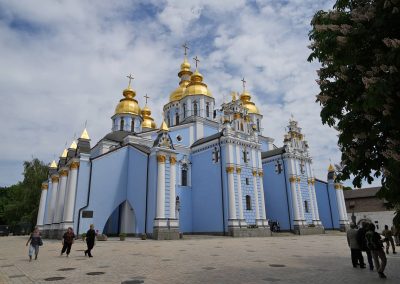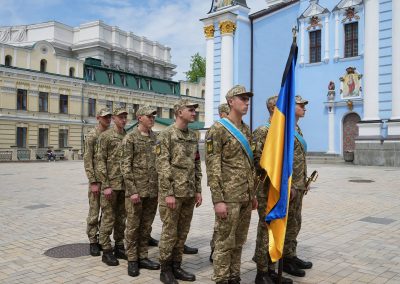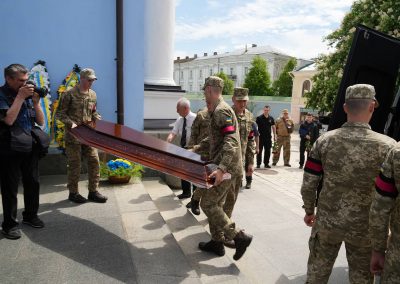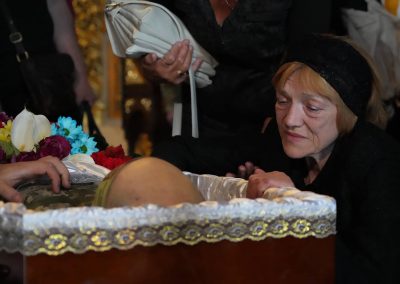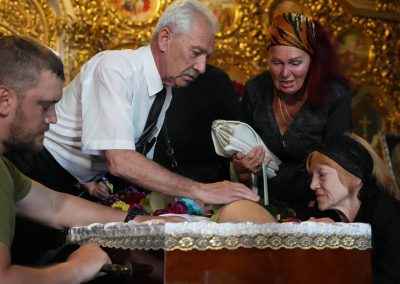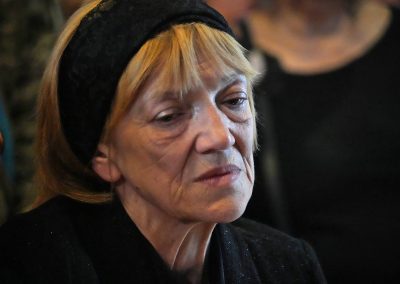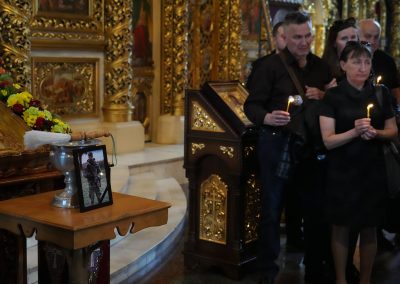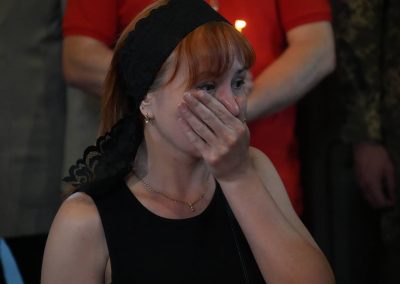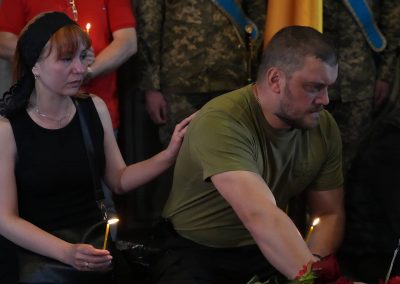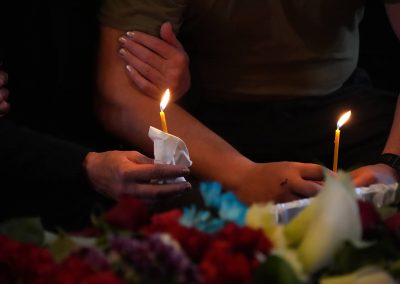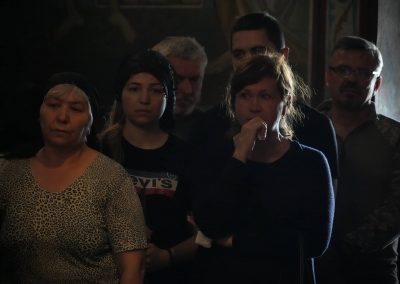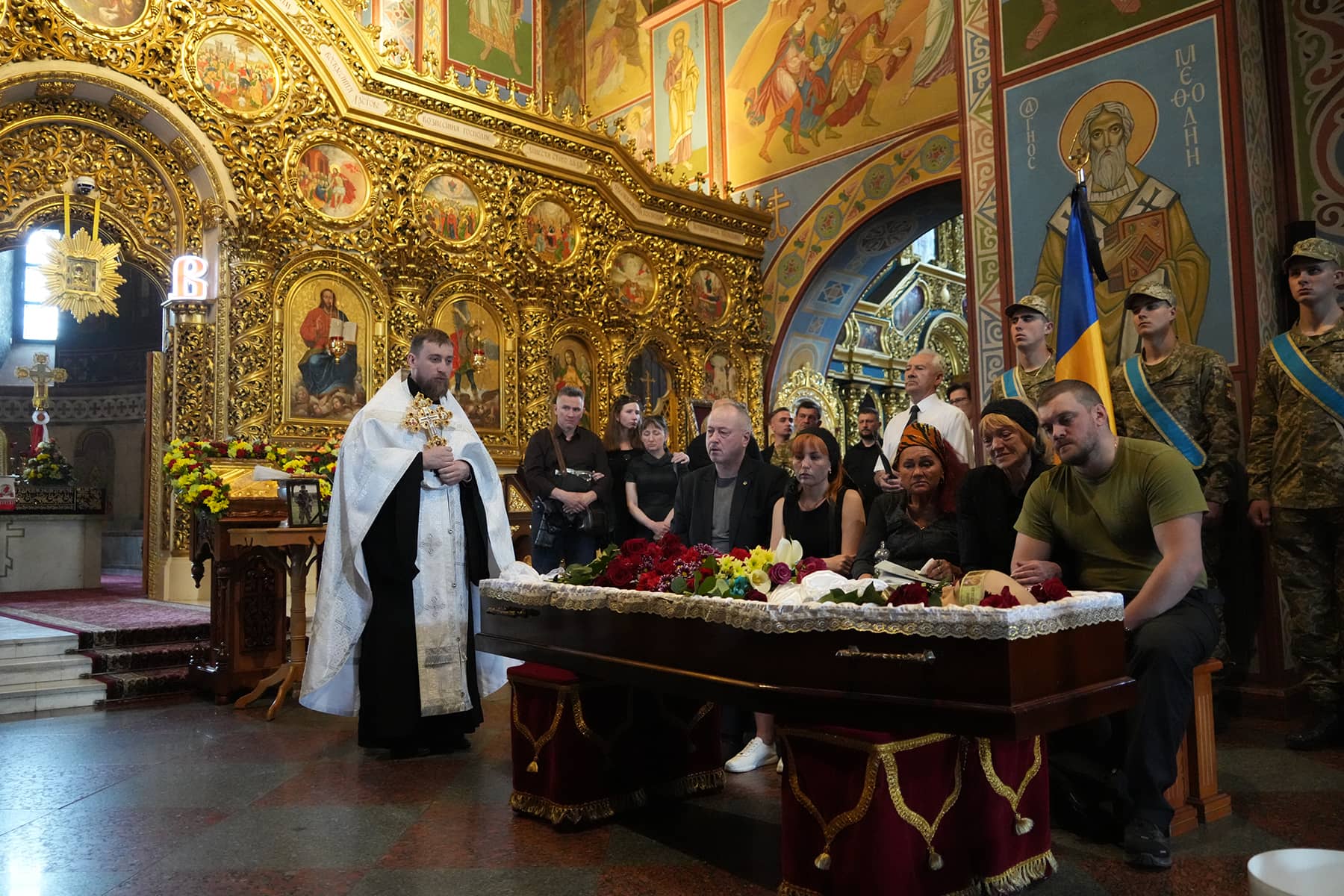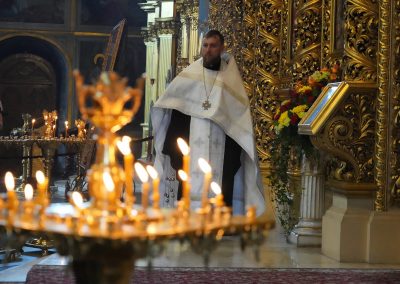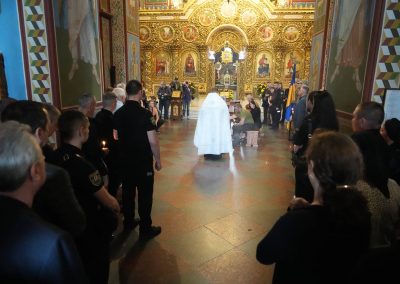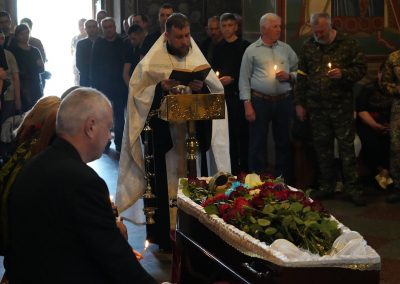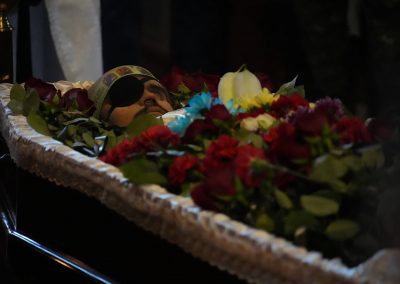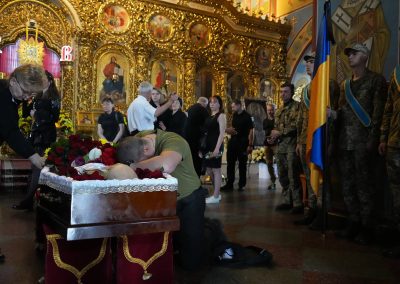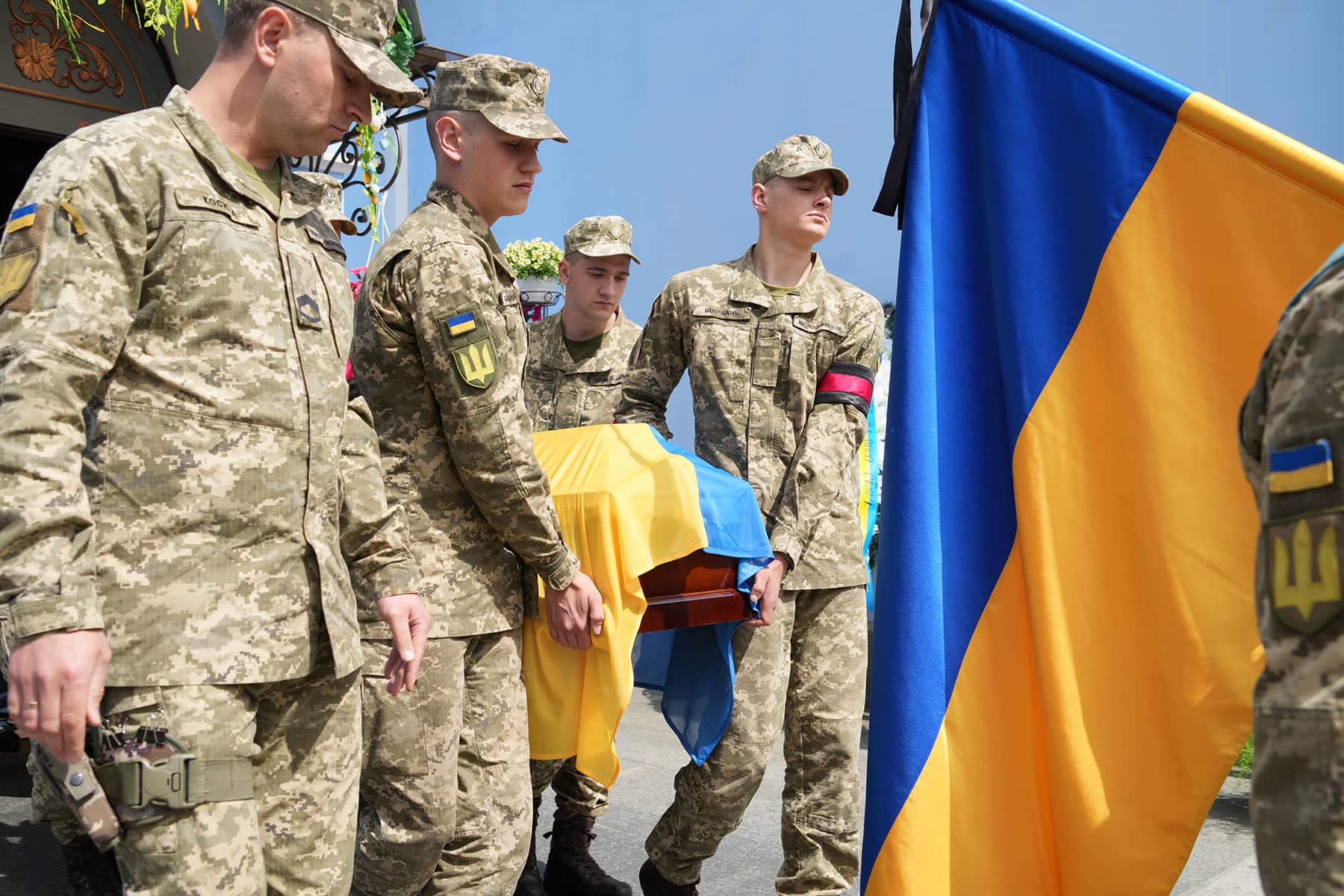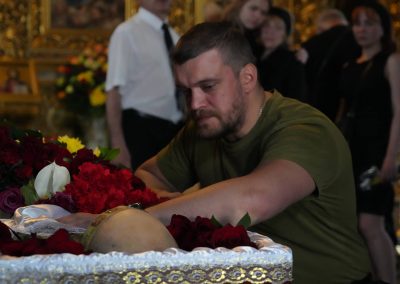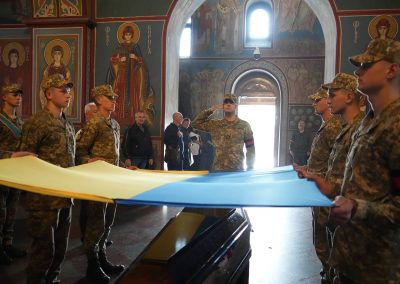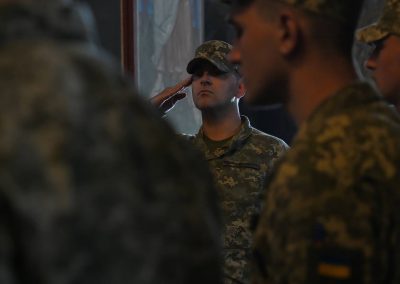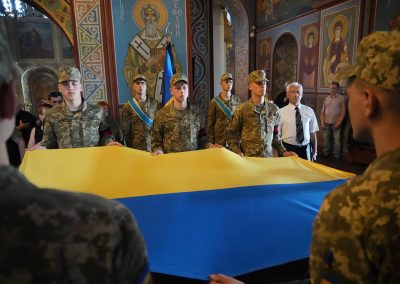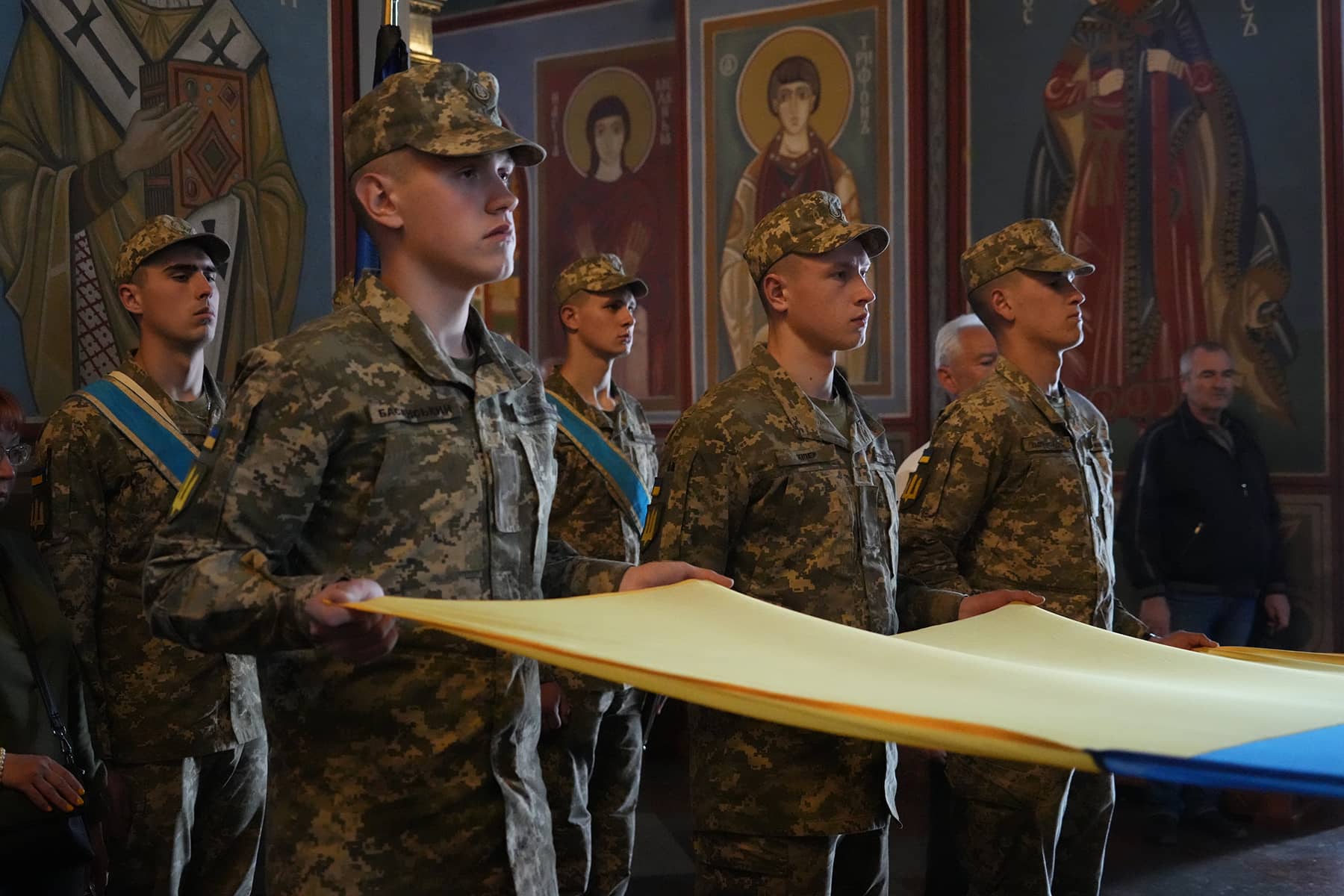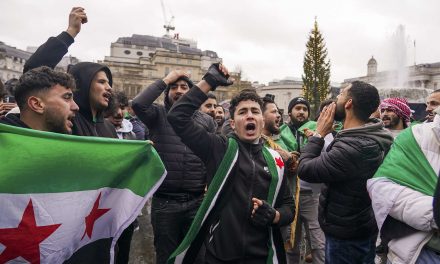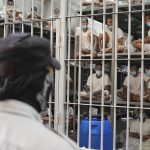
This is not a story specifically about a funeral, in the sense of a traditional news feature that focuses only on the details of the event. It is a story about the funeral of a young Ukrainian solider who died in combat. But it is told in the context of a Milwaukee photojournalist’s journey, and the chain of events that led to that encounter with the fallen hero.
I wrote about the death of my friend and Vietnam War Veteran Joseph F. Campbell during the early days of the Russian invasion of Ukraine in March. I also photographed his funeral, at the invitation of his family.
At the time, I was sorting out the details for taking a photojournalism assignment in Ukraine to cover the war on the frontlines, but the logistics kept changing and I was in a “hurry up and wait” mode.
I had not advanced notice that Joe’s funeral would be an open casket. That had a profound impact on me. I have covered many funerals, too many over the years, including my own father’s military burial. But in all my experiences, anyone who I had lost remained alive in my memory because I never saw them “after.”
I did not want to photograph Joe in his casket, let alone even see him in that condition so the memory would be forever lodged in my mind. But I was there to document the moment, not influence any aspect of it. While I would personally have turned away, professionally I felt a responsibility. The most important work I do is usually the most uncomfortable for me.
Photos of Joe’s funeral were shared with the public via social media. I had originally only selected a few, but people grieve differently and many who had not attended wanted to see more. With the family’s blessing I release more, but none of the open casket.
I had no idea why such images would ever be needed. But I did trust my instincts, and a spiritual pull that compelled me. I also knew that it was easier to take photos and never use them than not take photos and suddenly need them. In hindsight, it was never about the photos.
I have often experienced uncomfortable situations that prepared me for later events. It is impossible to discern many things in the moment, since they do not all have linear connections. Not everything in life is destiny.
At the time, I remember thinking that if the experience was having such a strong impact on me, then I had no business traveling to a war zone.
I can see that the point of taking photos that day was, in part, preparation for a situation I would later face. Like photographing a dead soldier’s open casket at a funeral in Kyiv two months later.
I have written previously about my own Ukrainian heritage, and what a distant war means here at home in Milwaukee.
> Read: What we are taught to be ashamed of: A tale of two grandmothers and our ethnic identity in America
By the time the Milwaukee Independent team finally arrived in Kyiv, the Russians had been driven from the region and the war moved to Ukraine’s South and East. However, their arrival and departure had left catastrophic wounds, most of which had not even begun the process of healing.
We spent every moment of each day interviewing war survivors at massacre sites and documenting the seemly still fresh conditions in images. It was a disparity between life improving and life standing still. There were places where existence was normal, right next to others frozen in time as if the war continued to rage.
After talking with our journalism team, both in Ukraine and back in Milwaukee, I decided to reschedule a day so we could just focus on something that was not terrible and broken. Basically, visit tourist sites to find some beauty as a contrast to all the ruined, rusted, and mutilated wreckage that was my landscape.
Our morning plans ran into some logistical issues, so we maneuvered into other situations which proved to be better opportunities. By the later part of the day we had returned to downtown Kyiv, near the center of the city where I was staying at Independence Square. It was ironic that I missed seeing so many of the treasures literally across the street. So time was made to experience them.
I call my neighborhood in Milwaukee “Church Alley” because there are six grand churches all within a few blocks that either date to the founding of the city or older. They are not old like European churches, Milwaukee’s faith community is only just approaching its bicentennial. And while they are not as grand as in the old country, the cathedrals in our city are a magnificent reflection of our history of faith.
And in Japan I had visited several ancient temples. The Horyuji Temple near Nara, for example, was built and rebuilt by 700 A.D., with its exterior complex completed within the following century. But it was not technically a church, in the sense that it was not connected to Christianity.
I had also seen historic Cathedrals in England and France, but always in passing. So Ukraine offered me the first chance to step inside an actual medieval Cathedral. I had seen many churches in Kyiv from a distance, but Saint Sophia was the first I had time to enter.
The architecture and history was a lot to process. What struck me was how much of the structure had been restored, but other areas were preserved in their original condition. The interior design was also fascinating, as paintings on walls aligned by standing at certain vantage points.
I did not have a spiritual experience, but I paused from taking photos to feel – what I can only describe as – the hand of God upon my heart.
And then I moved on, back outside where my team was waiting for me to return. Down the street was St. Michael’s Golden-Domed Monastery, which was a background for Mykhailivska Square where war protests were held and captured Russian armor was on display.
I did not plan to be inside very long, so my crew waited for me in the square. But that notion abruptly changed when I walked through the gates. In the courtyard I was met with the unexpected, and was very slow to realize what I had stepped into.
In Milwaukee, I often attend events at churches that have nothing to do with religious ceremonies. They are simply venues where public or patriotic gatherings are held. As soon as I saw a military color guard, my first thought was it appeared to be some kind of official ceremony. I was looking for a podium and a clue about who would be speaking.
Photographing any Ukrainian soldiers anywhere was a very sensitive issue, even for the news media – particularly because many had put lives at risk with their unfiltered coverage.
I thought it would be my one best chance, and instantly went into photo mode before my brain could process the situation. There were many other photojournalists around and TV cameras, so it had all the appearances of a press conference. Only it was not. It was a funeral.
The coffin lid removed from inside a minivan, used as a hearse, made the situation apparent. I had expected the day to be light and focused photographing architecture. Instead, I walked directly into full on grief and suffering.
Years ago I detailed the experience of documenting my own father’s military funeral as a keepsake for my grief-stricken brothers, at their insistence.
> Read: Inconvenient Images: How pictures teach us to see the world for what it is
It quickly became clear that the other photojournalists had covered funerals before, many times. They stood boldly in places I would have avoided out of respect. They knew exactly where to stand at each point in the process. While I mirrored them to explore where the boundary limits were, I did hold back in preference to error on the side of caution.
The scene around me was as beautiful as it was terrible. The misery and tears of the bereaved family was a stark contrast to the high gilded walls adorned with icons and artwork behind them.
Dozens of international photojournalists swirled around like flies, not completely irritating or interfering but still a distraction to the mourners. They recorded every intimate moment of the funeral gathering. And it struck me how common such a situation had become.
The family and friends, struggling with their grief, were captured in images for all the world to see. It was important to share, to show the loss and sacrifice Ukrainians make to protect their nation from Putin’s brutality. But it still felt surreal to be in the middle of that moment. To focus my camera on an open casket for the second time in two months. To think of my friend Joe, but be distant and emotionally disconnected from that memory and everything else around me.
When the service ended after an hour and the body was loaded for burial, I felt drained. I found my crew waiting outside, wondering why I had been gone so long but understanding after I mentioned the funeral.
I wanted to call it quits for the day, but there was still time left and things to do. So we continued on with our work, and I let the process distract my attention.
Because of the time difference, it was around then that I caught the headline of the Uvalde school shootings, another slaughter of innocent American children. I have reported on many such mass shootings over the years – too many for a society supposedly founded on the teachings of Jesus. The vigils surrounding them, the activist rallies pushing for gun safety laws, it has become a rebooted soap opera in my experience.
So I did not flinch at the news, after all I was in a country at war and terrible news was always the headline. But I did have a pause to consider the timing of the incident and where I found myself.
Before my departure from Milwaukee, I had developed a cynical reply for when anyone would ask me why I was going to Ukraine. I said that I had to go to a country at war just to take a vacation from America.
The Uvalde massacre made those words ring true. While I photographed the funeral of a Ukrainian patriot and processed my own grief about his sacrifice, the terrible events were playing out in Texas. What struck me first was simply the contrast of worlds.
I had witnessed a soldier be honored for his sacrifice. He died fighting for his nation’s independence against a brutal invader. While Ukrainians were fighting Russians and dying for their freedom, Americans continue to have little interest to protect the lives of their children.
In fact, they – specifically Conservative Republicans – have enabled making such autocracies so easy that before long school shootings will be a league sport and accept bets in Las Vegas for the point spread of the carnage.
In that moment, I wished my own homeland cared for its families and future generations as much as the Ukrainians did. If the Russians were monsters because they attacked neighbors to deny their descendants freedom, were American’s any less monstrous for allowing attacks that denied our nation the existence of future generations?
I cannot speak to the children lost in Texas, who died at the expense of profit and political power for other Americans. But I can speak about the funeral of the Ukrainian soldier on May 24.
His name was Eduard Trepilchenko. He was a scout with the 93rd Motorized Brigade. His call sign had been “Achilles,” and he died fighting the Russians near Kharkov on May 20.
A native of Luhansk, he could not endure what was happening to his hometown. In 2014 he volunteered in the Donbas battalion, and was discharged in 2020. After the Russian invasion at the beginning of 2022, he returned to the front again to defend his nation. He was 34-years-old.
“On the morning of February 24, my brother was one of the first to stand in line at the military registration and enlistment office. During the three months of the war, he accounted for dozens of destroyed enemy equipment, and several dozens – and maybe hundreds – of destroyed invaders. If each one of his brother soldiers who loved him could come to say goodbye to Eduard, then the front would be left without defenders. Each scout of the famous 93rd brigade was honored to carry out combat missions together with the Achilles,” said his brother, who did not publicly identify himself because of his active military service.
Trepilchenko was buried with full military honors at the Bortnychansʹkyy Cemetery in Kyiv.
© PHOTO NOTE: All the original editorial images published here have been posted to the Facebook page of Milwaukee Independent. That collection of photos contains the MI copyright and watermark for attribution, and may be used for private social media sharing. Do not download and share images directly from this page. mkeind.com/facebook
Series: Reports from Ukraine
- Reports from Ukraine: Traveling from Milwaukee to a country at war just to take a vacation from America
- Images from Ukraine: Latino artist travels to Irpin to paint mural inspired by "Echoes of Guernica"
- Images from Ukraine: Irpin residents welcome reissue of Russian Warship Stamp as latest sign of victory
- Stories from Ukraine: Wandering in the ruins of a shattered life after surviving Russia's invasion
- Images from Ukraine: Similar to the Alamo, martyred cities bought precious time to save a nation
- Stories from Ukraine: Tent camp offers shelter for displaced residents until Irpin can rebuild lost homes
- Images from Ukraine: Graveyards of Russian war machines show the scale of Putin's failure to seize Kyiv
- Images from Ukraine: Following the invasion convoy's 40-mile route and exploring an abandoned base
- Stories from Ukraine: Illegal weapons and proof of Russian War Crimes easily seen along streets of Irpin
- Images from Ukraine: How Irpin’s cemetery processed the staggering massacre of its local citizens
- Stories from Ukraine: Healing remains slow as Borodyanka residents recover from occupation
- Images from Ukraine: The deep scars of war remain visibly etched across the landscape of Borodyanka
- Interview with Oleksandr Markushin: Mayor of Irpin and the hero of a Hero City
- A Meeting of Sister Cities: Former and current Mayors of Irpin ask Milwaukee's business community for help
- Stories from Ukraine: Having a shared purpose helped Irpin's leaders protect the city and stop the invaders
- Stories from Ukraine: How Milwaukee helped a bakery feed hungry survivors in Bucha with fresh bread
- Stories from Ukraine: Bucha resident recalls how Russians turned neighborhood into a street of death
- Stories from Ukraine: How a mass grave of executions overshadowed accountability from Bucha’s leadership
- Images from Ukraine: Putin’s attack on Babyn Yar is a painful reminder of the broken vow of “Never Again”
- Images from Ukraine: An unexpected encounter with Jewish history and the bloody legacy of persecution
- Images from Ukraine: Listening to timeless voices of ethnic heritage etched in stone at Lychakiv Cemetery
- Images from Ukraine: The experience of attending a military funeral in Kyiv while children died in Uvalde
- Images from Ukraine: Stepping out of the fog of war to see the beauty of faith in ancient places of worship
- Images from Ukraine: The cities of Kyiv and Lviv were divided by history but remain united in identity
- Stories from Ukraine: Anya Nakonechna shares why the Lviv Opera is a symbol of her nation’s culture
- Images from Ukraine: A folk village where visitors can experience the life of past generations
- Images from Ukraine: Signs of renewal sprout from under Irpin’s rubble as city looks to the future
Lее Mаtz
Lее Mаtz and Eduard Trepilchenko
Milwaukee Independent editorial team for this special series: (UKRAINE) Lee Matz, photojournalist; Oleh Pinta, translator / reporter; Yaroslav Zdyrko, security / videographer; (MILWAUKEE) Halyna Salapata, logistics / translations.
Milwaukee Independent has reported on the situation in Ukraine since it was invaded on February 24. Coverage originally began with reactions and rallies from the local Ukrainian American community, and relationships with Milwaukee’s sister city of Irpin. Through partnerships and good journalism, sources were developed that enabled Milwaukee Independent to publish developments about the unprovoked war in realtime. In late May, a team from Milwaukee Independent spent nearly two weeks on the ground in Ukraine. The award-winning daily news magazine was the first and, at the time, only media organization to send staff into the country since the war began.
Reports from Ukraine: An extensive news series by Milwaukee Independent from a country at war







